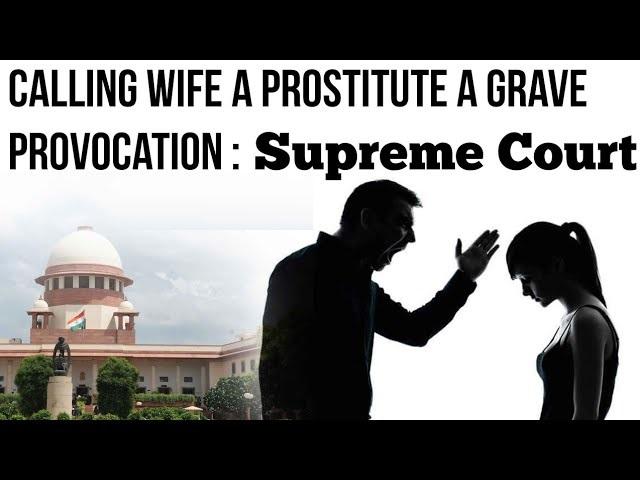Table of Contents
Issue
- A husband calling his wife a prostitute would amount to ‘grave provocation’ and the death caused in such an instance would be punishable as culpable homicide not amounting to murder, the Supreme Court has ruled.
Background
- The woman in question was having an extramarital affair. On the day of the incident, her husband called her and their elder daughter “prostitutes”.
- The bench of judges comprising justices MM Shantanagoudar and Dinesh Maheshwari converted the conviction under Section 302 IPC (murder) to Section 304 Part I IPC (culpable homicide not amounting to murder), and said: “The deceased provoked the accused by uttering the word ‘prostitute’. In our society, no lady would like to hear such a word from her husband. Most importantly, she would not be ready to hear such a word against her daughters. The incident is a result of a sudden and grave provocation by the deceased.”
Culpable homicide
- Whoever causes death by doing an act with the intention of causing death, or with the intention of causing such bodily injury as is likely to cause death, or with the knowledge that he is likely by such act to cause death, commits the offence of culpable homicide.
- Culpable Homicide is not amounting to murder:
I. Provocation.
II. Right of private defense.
III. Public servant exceeding his power.
IV. Sudden fight.
V. Consent.
- Exception-1-culpable homicide is not amounting to murder if the offender, whilst deprive of self control by grave and sudden provocation, caused the death of the person who gave the provocation or causes the death of any person by mistake or accident.
- The above exception is subject to the following provisos: Firstly.-That the provocation is not sought or voluntarily provoked by the offender as an excuse for killing or doing harm to any person. Secondly.-That the provocation is not given by anything done in obedience to the law, or by a public servant in the lawful exercise of the powers of such public servant. Thirdly.-That the provocation is not given by anything done in the lawful exercise of the right of private defence.
Illustrations
- a) A, under the influence of passion excited by a provocation given by Z, intentionally kills Y, Z’s child. This is murder, inasmuch as the provocation was not given by the child, and the death of the child was not caused by accident or misfortune in doing an act caused by the provocation. (b)
- Y gives grave and sudden provocation to A. A, on this provocation fires a pistol at Y, neither intending nor knowing himself to be likely to kill Z, who is near him, but out of sight. A kills Z. Here A has not committed murder, but merely culpable homicide.
- (c) A is lawfully arrested by Z, a bailiff. A is excited to sudden and violent passion by the arrest, and kills Z. This is murder, inasmuch as the provocation was given by a thing done by a public servant in the exercise of his powers.
- (d) A appears as a witness before Z, a Magistrate. Z says that he does not believe a word of A’s deposition, and that A has perjured himself, A is moved to sudden passion by these words, and kills Z. This is murder.
- (e) A attempts to pull Z’s nose. Z, in exercise of the right of private defense, lays hold of A to prevent him from doing so. A is moved to sudden and violent passion in consequence, and kills Z. This is murder, inasmuch as the provocation was given by a thing done in the exercise of the right of private defense.
- (f) Z strikes B. B is by this provocation excited to violent rage. A, a by stander, intending to take advantage of B’s rage, and to cause him to kill Z, puts a knife into B’s hand for that purpose. B kills Z with the knife. Here B may have committed only culpable homicide, but A is guilty of murder. If death is the most likely result of an act, it will be murder.
- If death is the likely result of an act, it will be culpable homicide not amounting to murder.
Contentions?
- Let’s examine this judgement.
- There was no reason for the second accused to feel “Provoked”who was the one, who
initiated the attack.
























 WhatsApp
WhatsApp